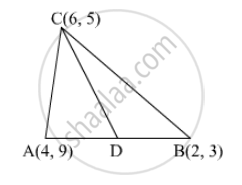Advertisements
Advertisements
प्रश्न
If A(4, 9), B(2, 3) and C(6, 5) are the vertices of ∆ABC, then the length of median through C is
विकल्प
5 units
- \[\sqrt{10}\] units
25 units
10 units
उत्तर
It is given that A(4, 9), B(2, 3) and C(6, 5) are the vertices of ∆ABC.

Let CD be the median of ∆ABC through C. Then, D is the mid-point of AB.
Using mid-point formula, we get
Coordinates of D = \[\left( \frac{4 + 2}{2}, \frac{9 + 3}{2} \right) = \left( \frac{6}{2}, \frac{12}{2} \right) = \left( 3, 6 \right)\]
∴ Length of the median, AD
\[= \sqrt{\left( 6 - 3 \right)^2 + \left( 5 - 6 \right)^2} \left( \text{ Using distance formula } \right)\]
\[ = \sqrt{3^2 + \left( - 1 \right)^2}\]
\[ = \sqrt{10} \text{ units } \]
Thus, the length of the required median is \[\sqrt{10}\] units.
APPEARS IN
संबंधित प्रश्न
The base PQ of two equilateral triangles PQR and PQR' with side 2a lies along y-axis such that the mid-point of PQ is at the origin. Find the coordinates of the vertices R and R' of the triangles.
Which point on the y-axis is equidistant from (2, 3) and (−4, 1)?
Find the centre of the circle passing through (5, -8), (2, -9) and (2, 1).
If the poin A(0,2) is equidistant form the points B (3, p) and C (p ,5) find the value of p. Also, find the length of AB.
If the point P (2,2) is equidistant from the points A ( -2,K ) and B( -2K , -3) , find k. Also, find the length of AP.
The midpoint P of the line segment joining points A(-10, 4) and B(-2, 0) lies on the line segment joining the points C(-9, -4) and D(-4, y). Find the ratio in which P divides CD. Also, find the value of y.
Point P(x, 4) lies on the line segment joining the points A(−5, 8) and B(4, −10). Find the ratio in which point P divides the line segment AB. Also find the value of x.
If (0, −3) and (0, 3) are the two vertices of an equilateral triangle, find the coordinates of its third vertex.
If three points (x1, y1) (x2, y2), (x3, y3) lie on the same line, prove that \[\frac{y_2 - y_3}{x_2 x_3} + \frac{y_3 - y_1}{x_3 x_1} + \frac{y_1 - y_2}{x_1 x_2} = 0\]
If A (1, 2) B (4, 3) and C (6, 6) are the three vertices of a parallelogram ABCD, find the coordinates of fourth vertex D.
If x is a positive integer such that the distance between points P (x, 2) and Q (3, −6) is 10 units, then x =
If A (5, 3), B (11, −5) and P (12, y) are the vertices of a right triangle right angled at P, then y=
The line segment joining points (−3, −4), and (1, −2) is divided by y-axis in the ratio.
If Points (1, 2) (−5, 6) and (a, −2) are collinear, then a =
f the coordinates of one end of a diameter of a circle are (2, 3) and the coordinates of its centre are (−2, 5), then the coordinates of the other end of the diameter are
What is the nature of the line which includes the points (-5, 5), (6, 5), (-3, 5), (0, 5)?
The line segment joining the points A(2, 1) and B (5, - 8) is trisected at the points P and Q such that P is nearer to A. If P also lies on the line given by 2x - y + k= 0 find the value of k.
In which quadrant, does the abscissa, and ordinate of a point have the same sign?
